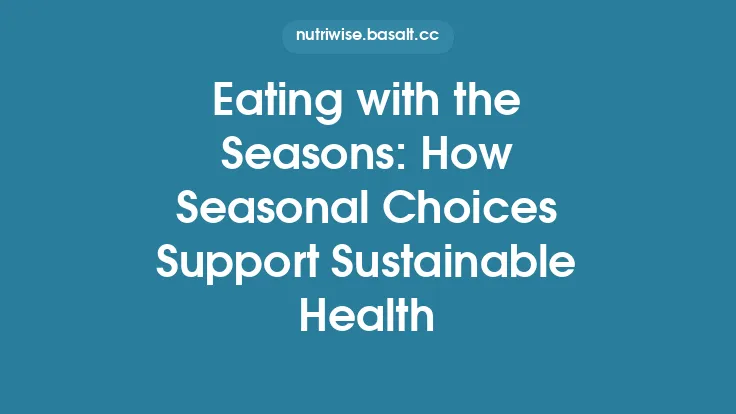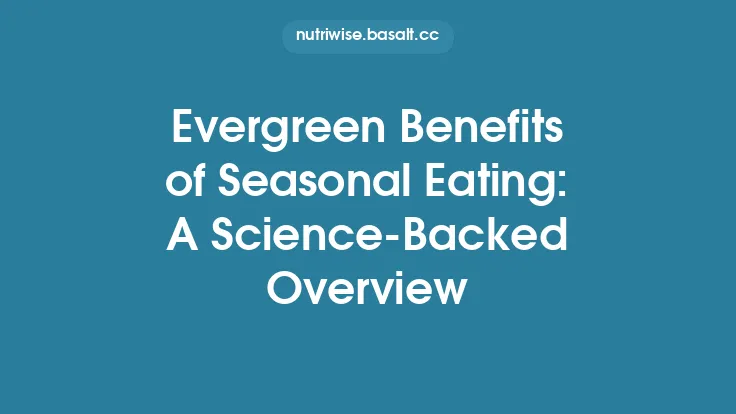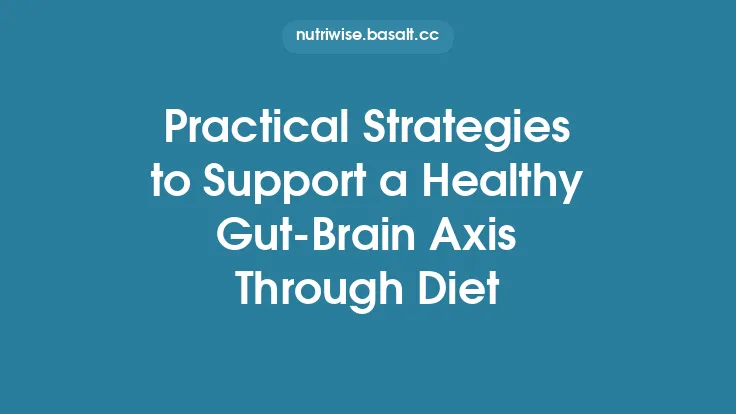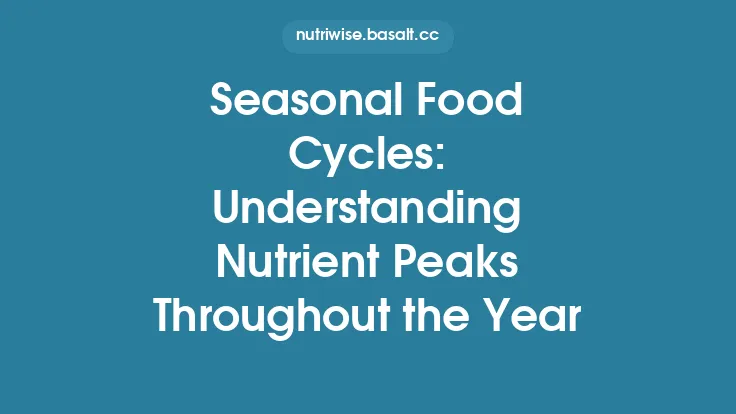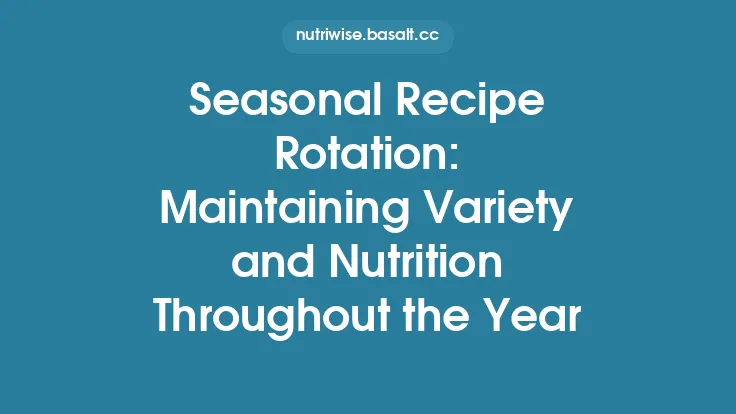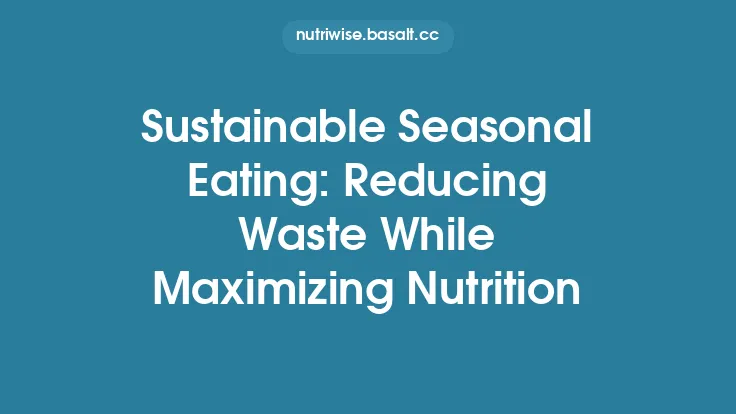The concept of “eating the rainbow” is more than a colorful marketing slogan; it is a scientifically grounded strategy for maximizing the intake of dietary antioxidants throughout the year. Antioxidants are a diverse group of phytochemicals that help neutralize reactive oxygen species (ROS) and mitigate oxidative stress, a key driver of chronic disease, aging, and inflammation. By aligning food choices with the natural ebb and flow of seasonal produce, you can tap into the peak phytochemical concentrations that each crop offers, while also enjoying the sensory variety that keeps a long‑term eating plan both satisfying and sustainable.
Understanding Antioxidants and Their Role in Health
Antioxidants encompass several classes of compounds, each with distinct chemical structures and mechanisms of action:
| Class | Representative Compounds | Primary Mechanism | Typical Food Sources |
|---|---|---|---|
| Polyphenols | Flavonoids (quercetin, catechins), anthocyanins, resveratrol | Scavenge free radicals, modulate signaling pathways (e.g., NF‑κB) | Berries, apples, tea, dark chocolate |
| Carotenoids | β‑carotene, lycopene, lutein, zeaxanthin | Quench singlet oxygen, protect membranes | Carrots, tomatoes, corn, leafy greens |
| Vitamin C (ascorbic acid) | Ascorbate | Direct electron donor, regenerates other antioxidants | Citrus, kiwi, bell peppers |
| Vitamin E (tocopherols & tocotrienols) | α‑tocopherol | Lipid‑phase radical termination | Nuts, seeds, vegetable oils |
| Glutathione precursors | Cysteine, glycine, glutamate | Support endogenous antioxidant synthesis | Cruciferous vegetables, garlic, onions |
These compounds do not act in isolation. In vivo, they form a dynamic network where one antioxidant can regenerate another (e.g., vitamin C regenerates vitamin E), creating a cascade of protection that extends beyond the capacity of any single molecule.
The Science of Color: Why a Rainbow Matters
The vivid hues of fruits and vegetables are visual cues for specific phytochemical families:
- Red & Pink – Lycopene, anthocyanins, and certain flavonoids. These are potent singlet‑oxygen quenchers and have been linked to reduced risk of cardiovascular disease.
- Orange & Yellow – β‑carotene and other carotenoids that serve as provitamin A, essential for vision and immune function.
- Green – Chlorophyll‑bound compounds such as lutein and zeaxanthin, which protect ocular health and exhibit anti‑inflammatory properties.
- Blue & Purple – Delphinidin‑based anthocyanins, notable for their ability to modulate endothelial function and improve lipid profiles.
- White & Brown – Sulfur‑containing compounds (e.g., allicin) and certain phenolics that support detoxification pathways.
By deliberately selecting foods across the color spectrum, you ensure a broad intake of antioxidant classes, each contributing uniquely to cellular resilience.
Seasonal Antioxidant Profiles: A Year‑Round Overview
While the exact calendar can shift by region, the following general patterns illustrate how antioxidant density peaks at different times of the year. The emphasis is on relative concentrations rather than exhaustive lists of specific produce.
| Season | Dominant Colors & Corresponding Antioxidants | Typical High‑Antioxidant Foods (Broad Categories) |
|---|---|---|
| Early Spring | Light greens, pale yellows | Tender leafy greens (e.g., early lettuce, mizuna), young peas, radishes |
| Late Spring | Bright pinks & reds | Early berries (e.g., strawberries), rhubarb, young carrots |
| Summer | Deep blues, purples, and vivid reds | Full‑season berries, stone fruits, heirloom tomatoes, corn |
| Early Autumn | Rich oranges & deep greens | Squash varieties, late‑season carrots, kale, beetroot |
| Late Autumn | Earthy browns & deep reds | Pomegranates, persimmons, late‑season apples, turnips |
| Winter | Pale greens & whites | Cruciferous families (e.g., Brussels sprouts, cabbage), citrus, parsnips |
Key Insight: The antioxidant content of a given crop often reaches its zenith when the plant is harvested at full maturity and under optimal climatic conditions. For example, lycopene in tomatoes spikes as the fruit ripens fully on the vine, while anthocyanin levels in berries increase with cooler night temperatures.
Optimizing Bioavailability Through Preparation and Cooking
The mere presence of antioxidants in food does not guarantee absorption. Several factors influence bioavailability:
- Matrix Disruption
- Mechanical processing (chopping, pureeing) breaks cell walls, exposing phytochemicals. A smoothie of mixed berries typically yields higher plasma anthocyanin levels than whole berries eaten alone.
- Heat Treatment
- Carotenoids become more bioavailable after gentle cooking with a small amount of fat (e.g., sautéed carrots in olive oil). Heat disrupts the crystalline structure, facilitating micelle formation in the gut.
- Polyphenols can be sensitive to prolonged high heat; brief blanching or steaming preserves flavonoid content while reducing antinutrients that impede absorption.
- pH and Enzymatic Interactions
- Vitamin C is stable in acidic environments; adding a squeeze of lemon to a vegetable dish can protect ascorbate from oxidation.
- Fermentation (e.g., kimchi) can increase the availability of certain phenolics by microbial enzymatic conversion.
- Fat Solubility
- Lutein, zeaxanthin, and other carotenoids require dietary fat for efficient uptake. Pairing leafy greens with avocado, nuts, or a drizzle of oil maximizes absorption.
- Synergistic Pairings
- Quercetin and vitamin C exhibit a synergistic effect, where vitamin C regenerates oxidized quercetin, extending its antioxidant capacity. A salad combining red onions (quercetin) with citrus dressing (vitamin C) exemplifies this principle.
Strategic Pairings and Synergistic Effects
Beyond individual foods, the combination of multiple antioxidant sources can produce additive or even multiplicative health benefits:
- The “Rainbow Bowl” Model – Construct a meal that includes at least five distinct colors, each representing a different antioxidant class. For instance, a bowl containing quinoa (white), roasted beetroot (red), sautéed kale (green), orange carrots, and a blueberry vinaigrette (blue) delivers a spectrum of polyphenols, carotenoids, and vitamins.
- Antioxidant‑Rich Condiments – Incorporate sauces and dressings that are themselves antioxidant powerhouses, such as tahini (rich in sesamol, a lignan antioxidant) or pesto made with basil (contains rosmarinic acid).
- Timing of Consumption – Some research suggests that spacing antioxidant‑rich meals throughout the day maintains a steadier plasma antioxidant capacity, rather than clustering them in a single large meal.
Practical Tips for Incorporating Seasonal Antioxidants Daily
- Plan Around Market Cycles
- Visit local farmers’ markets early in the week to capture the freshest, most nutrient‑dense produce. Seasonal peaks often align with the first harvest of the week.
- Batch‑Prep Colorful Bases
- Roast a tray of mixed root vegetables (e.g., carrots, parsnips, beets) and store in the fridge for quick addition to salads, grain bowls, or soups.
- Utilize Frozen Options Wisely
- Freezing at peak ripeness locks in antioxidant levels. A bag of frozen mixed berries can be a reliable source of anthocyanins when fresh fruit is out of season.
- Incorporate Whole‑Food Snacks
- Keep a stash of raw, colorful vegetables (e.g., bell pepper strips, cherry tomatoes) and a small container of hummus or nut butter for on‑the‑go antioxidant boosts.
- Mindful Cooking Techniques
- Opt for steaming, quick sautéing, or roasting with minimal oil to preserve heat‑sensitive compounds while still enhancing the bioavailability of fat‑soluble antioxidants.
- Track Color Diversity
- Use a simple visual log: each day, aim to “check off” at least three different color groups. This habit reinforces variety without requiring meticulous nutrient calculations.
Common Myths and Evidence‑Based Clarifications
| Myth | Reality |
|---|---|
| “More antioxidant supplements equal better health.” | Whole foods provide a complex matrix of antioxidants that work synergistically; isolated supplements often lack this interplay and can, in high doses, act pro‑oxidatively. |
| “All red foods are high in lycopene.” | Red pigments can arise from anthocyanins (e.g., red cabbage) or betalains (e.g., beets). Only tomatoes and certain pink fruits are significant lycopene sources. |
| “Cooking destroys all antioxidants.” | While some heat‑labile compounds (e.g., vitamin C) diminish with prolonged cooking, others (e.g., lycopene, certain flavonoids) become more bioavailable. |
| “If a food is orange, it must be high in β‑carotene.” | Orange pigments can also stem from flavonoids or anthocyanins; β‑carotene is predominant in carrots and sweet potatoes but not in all orange produce. |
| “Seasonal produce is always more antioxidant‑rich than imported varieties.” | Seasonal, locally harvested produce often has higher antioxidant levels due to reduced transport time, but specific cultivars and post‑harvest handling also play crucial roles. |
Monitoring Intake and Adjusting for Individual Needs
While a rainbow‑centric approach is universally beneficial, individual factors may necessitate fine‑tuning:
- Genetic Polymorphisms – Variants in genes such as *GST (glutathione S‑transferase) or SOD2* (superoxide dismutase) can affect how efficiently a person utilizes certain antioxidants. Nutrigenomic testing can guide personalized emphasis (e.g., higher flavonoid intake for those with reduced GST activity).
- Medical Conditions – Patients on anticoagulant therapy should moderate high‑vitamin K greens, while those with iron‑overload disorders may need to balance high‑iron, antioxidant‑rich foods (e.g., spinach) with iron‑chelating strategies.
- Age and Life Stage – Older adults often benefit from increased lutein/zeaxanthin for ocular health, while athletes may prioritize rapid‑acting antioxidants like vitamin C and polyphenol‑rich berries for recovery.
Regularly reviewing dietary patterns—through food diaries, mobile tracking apps, or periodic consultations with a registered dietitian—helps ensure that antioxidant intake remains aligned with health goals and lifestyle changes.
Conclusion: Building a Resilient Antioxidant Foundation
Seasonal antioxidant strategies are a pragmatic, evidence‑based pathway to harness the full protective potential of plant‑derived phytochemicals. By:
- Understanding the diverse antioxidant families and their mechanisms,
- Leveraging the natural color cues that signal specific compounds,
- Aligning food choices with seasonal peaks to capture maximal phytochemical density,
- Optimizing preparation methods to enhance bioavailability,
- Strategically pairing foods for synergistic effects, and
- Adapting intake to personal health contexts,
you create a dynamic, resilient nutritional framework that supports cellular health year‑round. The rainbow is not merely a visual metaphor; it is a practical roadmap to a diet rich in the antioxidants our bodies need to thrive amidst the oxidative challenges of modern life. Embrace the seasonal palette, and let each bite be a step toward lasting vitality.
